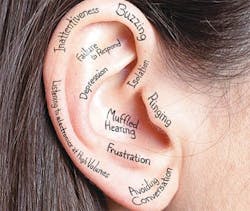In a perfect world, all construction workers would protect themselves from excessive noise exposure, but in the real world that just doesn't happen. The Centers for Disease Control (CDC) says that the number of workers with occupational noise-induced hearing loss (NIHL) is grossly underestimated because of inadequate testing, hearing conservation programs, and workers reluctance to discuss their hearing issues.
Meanwhile, the CDC's National Institute for Occupational Safety & Health (NIOSH) says that 73 percent of construction workers are exposed to noise over the recommended exposure limit, (around 85 decibels) with equipment operators leading the group at 77 percent. Twenty-three percent of workers exposed to occupational noise report hearing difficulty, 15 percent report dealing with tinnitus (those ringing or buzzy sounds in your ear), and 9 percent report both. Keep in mind, those percentages come from people who are aware and willing to report their hearing problems.
The safety risk of NIHL on job sites is two-fold. The worker experiencing hearing loss may not recognize hazardous situations such as working around heavy equipment or take notice when a machine sounds an audio alert or understand what is being said when multiple people are speaking. That worker's muddled comprehension of what is happening on the job can lead to missteps that impact the safety of other workers. For example, one worker might yell instructions to another worker, who may nod to acknowledge he was being spoken to, but really has no idea what was being said.
What to do about hearing loss
First, know what hearing impairment actually is. For some people, volume is the issue, either too little or too much. But for other people, hearing loss can be the inability to hear specific tones no matter how loud they may be, or not being able to distinguish between sounds and speech. Others may experience hearing impairment by a physical pain reaction to sounds that then interrupts the hearing process. Some people's hearing impairment comes and goes, or varies in intensity. Hearing impairment or partial loss is not the same as deafness. No two people experience it the same way.
Make hearing impairment and loss part of your company-sponsored safety programs and daily safety talks. Educate workers why hearing protection is important and what they can do to protect themselves. Make sure effective hearing protectors are always on hand.
Not hearing well isn't something that is done on purpose or with intent. Occupational NIHL is a physical result of exposure to too much noise on the job, but there are many other things that can compromise normal hearing.
Supervisors should be aware of employees who might have temporary hearing loss due to an accident or prescription medication. Employees may not volunteer their information (or even be aware of it themselves), so foremen and other supervisory personnel need to know what to look for when a worker is experiencing hearing loss.
Signs include:
- The worker seems to have trouble hearing a phone conversation
- Asks people to repeat what has been said, especially in group situations or in areas with hard surfaces
- Seems annoyed with fellow worker's mumbling
- Fails to respond
- Cocks their head or moves to listen to the speaker with their 'good ear'
- Looks at the speaker as if they are talking in a different language
- Changes in the worker's own voice volume or speech pacing
- Seems unsure of where a sound is coming from
- Displays unusual fatigue or headaches
- Incorrectly completes verbal directions
- Seems to startle easily
- Some workers will compensate for their hearing loss by removing their hearing protection
Enforce redundant communication procedures. Backup alarms on heavy equipment should be partnered with warning lights. Telematic devices should use sounds, visuals, and vibrations when available. Follow a call with a test. Partner pop-up alerts with voice or vibration alerts.
Ensure that communications between two people or groups are acknowledged in two separate ways. A verbal command should be acknowledged by a visual response that is agreed upon before the task at hand begins. Direction given using electronic devices should be answered with a reply that requires the receiving person to input a defined response.
Customize emergency action procedures like those in place for severe weather or fires so that the alert and following instructions are available several ways. Use other audio alerts with varying sounds and, visual notifications such as flashing lights or colors.
Identify new safety concerns at new job sites. The acoustics on the site may be very different that those on a previous site, causing even the best ears to struggle.
Layout and highlight specific paths of travel for vehicles, heavy equipment and lift machines.
Sensor warning lights that blink when a vehicle approaches are helpful.
Caption visual training aids.
None of these adjustments is difficult or time consuming. We need to take hearing protection and loss as seriously as we take eye and body protection.





